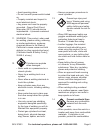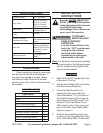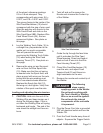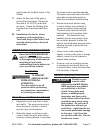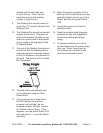Page 4SKU 97503 For technical questions, please call 1-800-444-3353.
Electrical safety2.
Avoid body contact with grounded a.
surfaces such as pipes, radiators,
ranges and refrigerators. There is
an increased risk of electric shock if
your body is grounded.
Do not expose power tools to rain b.
or wet conditions. Water entering a
power tool will increase the risk of
electric shock.
Do not abuse the cord. Never use c.
the cord for pulling or unplugging the
power tool. Keep cord away from
heat, oil, sharp edges or moving
parts. Damaged or entangled cords
increase the risk of electric shock.
When operating a power tool d.
outdoors, use an extension cord
suitable for outdoor use. Use of
a cord suitable for outdoor use
reduces the risk of electric shock.
Personal safety3.
Stay alert, watch what you are a.
doing and use common sense
when operating a power tool. Do
not use a power tool while you are
tired or under the inuence of drugs,
alcohol or medication. A moment
of inattention while operating power
tools may result in serious personal
injury.
Use safety equipment. Always b.
wear eye protection. Safety
equipment such as arc shaded,
impact safety full face shield,
dust mask or respirator, heavy-
duty work gloves, non-skid safety
shoes, or hearing protection used
for appropriate conditions will
reduce personal injuries.
Avoid accidental starting. Ensure c.
the switch is in the off-position
before plugging in. Carrying power
tools with your nger on the switch
or plugging in power tools that have
the switch on invites accidents.
Remove any adjusting key or wrench d.
before turning the power tool on. A
wrench or a key left attached to a
rotating part of the power tool may
result in personal injury.
Do not overreach. Keep proper e.
footing and balance at all times.
This enables better control of the
power tool in unexpected situations.
Power tool use and care4.
Do not force the power tool. Use a.
the correct power tool for your
application. The correct power tool
will do the job better and safer at the
rate for which it was designed.
Do not use the power tool if the b.
switch does not turn it on and
off. Any power tool that cannot
be controlled with the switch is
dangerous and must be repaired.
Disconnect the plug from the c.
power source before making
any adjustments, changing
accessories, or storing power
tools. Such preventive safety
measures reduce the risk
of starting the power tool
accidentally.
Store idle power tools out of d.
the reach of children and do not
allow persons unfamiliar with the
power tool or these instructions
to operate the power tool. Power
tools are dangerous in the hands
of untrained users.
Maintain power tools. Check for e.
misalignment or binding of moving
parts, breakage of parts and any








